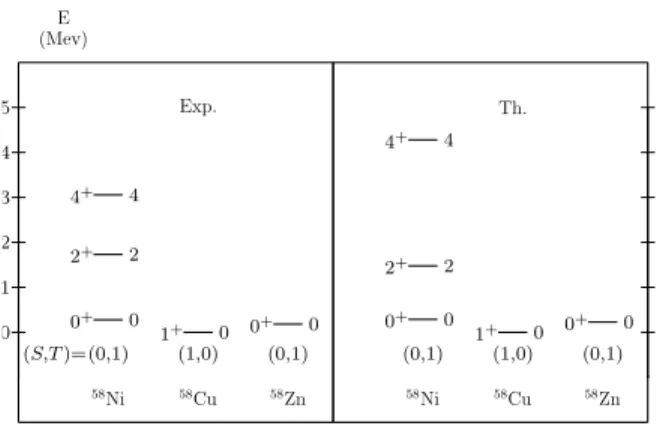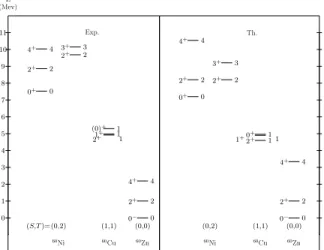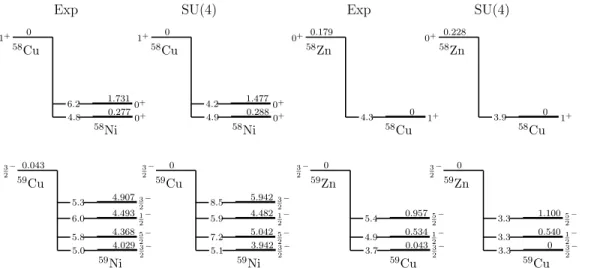Brazilian Journal of Physics, vol. 34, no. 3A, September, 2004 837
Pseudo-SU(4) Model and Beta Decay of pf-shell Nuclei
J. P. Valencia
Instituto de Fisica, Universidad de Antioquia, Medellin, Colombia
and H.C. Wu
Instituto de Fisica, Universidad de Antioquia, Medellin, Colombia
Received on 26 September, 2003
The spectra and the beta decay of the Ni-Cu-Zn isotopes with A=58, 59 and 60 are studied by using the pseudo-SU(4) model.
1
Introduction
The pf-shell (i.e. the 2p1
2-2p32-1f52 shell) is important for a
variety of problems in nuclear structure, however, the study of this shell has been hindered by the huge size of the shell model space. In recent years there have been studies by us-ing the Monte-Carlo shell model [1] and that based on the pseudo-SU(4) symmetry model [2].
The original Wigner Supermultiplet SU(4) model[3] is based on the spin-isospin symmetry of the nucleon-nucleon interaction. But the symmetry is broken by the l-s coupling and the breaking increases with the nucleon number. It has been established that the SU(4) symmetry works well in the p-shell [4, 5], but for the ds-shell the SU(4) symmetry is good only for nuclei withN ∼=Z[6, 7]. For nuclei beyond ds-shell the SU(4) symmetry is heavily broken due to large l-s coupling.
There have been efforts to restore symmetry for the nu-clei which have large l-s coupling by introducing the con-cept of pseudo-spin and pseudo-orbit[8]. The pseudo-SU(4) model [2] was proposed to deal with the pf-shell by com-bining the spin and the isospin. Since the pseudo-spin-pseudo-orbit splitting (between 1f5
2 and 2p32) is
sub-stantially smaller than the normal spin-orbit splitting (i.e. between 2p1
2 and 2p32), the breaking of the pseudo-SU(4)
symmetry is correspondingly smaller. The advantage of the pseudo-SU(4) symmetry is that it keeps all the algebraic fea-tures of the SU(4) model while incorporating large l-s cou-pling. A brief analysis in ref.[2] indicates that the pseudo-SU(4) model is promising for describing the pf-shell nuclei. This work intends to check the validity of the pseudo-SU(4) model by a comprehensive analysis of the spectra and the beta decays of the Ni-Cu-Zn isotopes withA=58, 59 and 60.
2
The Spectra
In the pseudo-SU(4) model we further assume that the pseudo-orbits have the SU(3) symmetry [5]. Note that
here-after the symmetries pseudo-SU(4) and pseudo-SU(3) are denoted as SU(4) and SU(3), respectively. Therefore the symmetry group chain for the pf-shell nuclei reads,
SU(4)⊗SU(6)⊃(SU(2)S⊗SU(2)T)⊗(SU(3)⊃SO(3)),
(1) where the SU(4) and SU(6) are the pseudo-spin-isospin symmetry and pseudo-orbital symmetry, respectively;
SU(2)SandSU(2)Tand SU(3) are their subgroups. A gen-eral form of the energy can be expressed as,
E=a1CSU4+a2S(S+ 1) +a3T(T+ 1) +a4CSU3
+a5L(L+ 1) +a6L·S, (2)
where CSUNare the second order Casimir operator of the SU(N) group, andS, T, LandJare the spin, isospin, the or-bital angular momentum and the total angular momentum, respectively.
First we study the Ni-Cu-Zn nuclei withA=58, orn=2 (nbeing the number of nucleons in the pf-shell). The irrep of SU(4)⊗SU(6) is as follows:
⊗ ,
where is the SU(4) irrep, and it can be decomposed to the states with(ST)=(01) and (10); the SU(6) irrep and its SU(3) irrep with largest symmetry is (4,0). The left hand side of Figure 1 lists the experimental levels with lowest en-ergies. We note that the experimental energy given in Figure 1 is the pure nuclear interaction, i.e. the binding energy with Coulomb energy being subtracted, and the nuclear energy of the ground state of58Znis taken as zero. The quantum num-bersSandLare also given to experimental levels in order to identify their theoretical counterparts.
Since all the levels belong to the same SU(4) irrep, and the(ST)=(01) and (10), only two parameters from eq. 2 are needed, which area3anda5. From fitting the five levels the two parameters can be determined as :a3= 0.114 anda5=
0.200 (all the parametersai are in MeV). The calculated
838 J.P. Valencia and H.C. Wu
Exp. E
(Mev)
0 1 2 3 4 5
(S,T)=
58Ni 58Cu 58Zn
0+ 0 2+ 2 4+ 4
(0,1) 1+ 0
(1,0) 0+ 0
(0,1)
Th.
58Ni 58Cu 58Zn
0+ 0 2+ 2 4+ 4
(0,1) 1+ 0
(1,0) 0+ 0
(0,1)
Figure 1. The spectra of the Ni-Cu-Zn nuclei with A=58. The experimental energies are pure nuclear interactions, and the theo-retical levels given by the SU(4)⊗SU(6) model. For each levelJπ
(to the left) represents the total angular momentum and parity, and
L(to the right) the orbital angular momentum. The spin-isospin number,(S, T), are given for each nucleus.
Considering that the energy difference between the ground states of58Niand58Znis less than 100 KeV while the total nuclear energies are around 634 MeV, one can easily conclude that the SU(2)T symmetry is almost ex-act. However, the calculated energy of4+(4.277 MeV) of 58Niis much higher than its experimental counterpart (3.053 MeV), which shows that the SU(3) symmetry is violated considerably.
Next we discuss the Ni-Cu-Zn nuclei with A=59, or
n=3. The irrep of SU(4)⊗SU(6) is:
⊗ .
The first diagram is the SU(4) irrep, and it can be de-composed to(S, T)=(1/2, 1/2), (1/2, 3/2) and (3/2, 1/2); the second diagram is the SU(6) irrep and its SU(3) irrep with largest symmetry is (4,1).
The left hand side of Fig. 2 lists the lowest experimen-tal levels. The calculated spectra are given in the right hand side of the same figure. The three relevant parameters can be determined through fitting the 10 levels:a3= 2.014, a5=
0.320 anda6=−0.360. TheSU(2)Tsymmetry is, again, almost exact for the case ofn=3. The spectra of the three nuclei are similar and the general fair agreement between experiment and theory is an evidence of the validity of the SU(4) symmetry. We note that the angular momentum as-signed to the two excited states of59Zn (E=0.540 and 0.900 MeV) is only tentative, and a confirmation of this assign-ment could provide a strong support for the SU(4) symme-try. In the experimental spectra of59Ni the5/2− level is
lower than1/2−, which indicates that the experimentalL=2
state is considerably lower than that predicted by the SU(3) symmetry. This is an indication of violation of the SU(3) symmetry.
Exp. E
(Mev)
0 1 2 3 4 5 6
59Ni 59Cu 59Zn (S,T)=
3 2
− 1 5 2 −
2 1 2
3 2 − 1 2 −
(1 2,
3 2)
2 1
3 2
− 1 5 2 − 1 2 −
(1 2,
1 2)
2 1
3 2
− 1 5 2 − 1 2 −
(1 2,
1 2)
Th.
59Ni 59Cu 59Zn
3 2 −
2
1 2
3 2
− 1 5 2 − 1 2 −
(1 2,
3 2)
2 1
3 2
− 1 5 2 − 1 2 −
(1 2,
1 2)
2 1
3 2
− 1 5 2 − 1 2 −
(1 2,
1 2)
Figure 2. The spectra of the Ni-Cu-Zn nuclei with A=59. See the caption of Fig. 1 for explanation of the signs.
Finally we discuss the Ni-Cu-Zn nuclei withA=60, or
n=4. There are three sets of irreps of SU(4)⊗SU(6):
⊗ ; ⊗ and ⊗ ,
which correspond to the Zn, Cu and Ni nuclei, respectively. In the first set the SU(4) irrep can be decomposed to
(S, T)=(0,0); is the the SU(6) irrep and its SU(3) ir-rep with the largest symmetry is (8,0). In the second set is the SU(4) irrep, and it can be decomposed to(S, T)=(1,1), (1,0) and (0,1); the is the SU(6) irrep and its SU(3) irrep with the largest symmetry is (6,1). In the third set the SU(4) irrep contains(S, T)=(0,2) and (1,2) etc, and the SU(6) irrep has the SU(3) irrep (4,2) etc.
The left hand side of Fig. 3 lists the lowest experimental levels, and the calculated spectra are given in the right hand side of the figure. The four relevant parameters can be de-termined from fitting the eleven levels, and the results are:
a1= 0.550, a3= 0.100, a5= 0.167 anda6=−0.031. The nuclei60Niand60ZnhaveS=0 thus there isJ=L. The low-lying states of60Niare contained in the SU(3) ir-rep (4,2) and those of60Znare in the SU(3) irrep (8,0). In both cases the levels are explained qualitatively by the SU(3) model. However, the quantitative rule of the energy of the SU(3) limit is violated, and the extent of the violation of SU(3) symmetry is similar to the case ofn=2 and 3. The ground state of60Cuis2+which belongs to the triplet 2, 1, and 0 that are produced by the coupling betweenS =1 andL=1. Experimentally there have been identified only
Brazilian Journal of Physics, vol. 34, no. 3A, September, 2004 839
Exp. E
(Mev)
0 1 2 3 4 5 6 7 8 9 10 11
60Ni 60Cu 60Zn
(S,T)= 4+ 4
2+ 2
0+ 0
3+ 3
2+ 2
(0,2)
(0)+ 1
1+ 1
2+ 1
(1,1) 4+ 4
2+ 2
0− 0 (0,0)
Th.
60Ni 60Cu 60Zn
4+ 4
2+ 2
0+ 0 3+ 3
2+ 2
(0,2)
0+ 1
2+ 1
1+ 1
(1,1) 4+ 4
2+ 2
0− 0 (0,0)
Figure 3. The spectra of the Ni-Cu-Zn nuclei withA=60. See cap-tion of Fig. 1 for explanacap-tion of the signs.
3
The beta decays
The Gamow-Teller beta decay operator writes as
MGT = √ 1
2Ji+ 1
f,i
f|
k
τkσk,µ |i, (3)
where |i and |f are the initial and final states with the pseudo-SU(4) symmetry, and k is the particle index. For the convenience of calculation one may take|iand|fas the normal SU(4) state in the ds shell, provided the Gamow-Teller operator undergoes a transformation as follows [2],
τkσk=−
τkσk
3 + 2
√ 10τk
Ck(2)⊗σk (1)
,
(4) where the quadrupole operator Ck(2) is given in ref. [10]. With the assumption that the pseudo-orbits obey the SU(3) symmetry [9], the Gamow-Teller matrix elements can be de-rived as follows,
⌋
MGT =
2Jf+ 1 (2Ji+ 1)(2T′+ 1)
T MT1ν|T
′
MT′S ′
T′||σ τ||S T
(−1)Jf+S+L 3
Ji Jf 1
S′ S L
δL′L− 2
10
3
L′ L 2
S′ S 1
Jf Ji 1 L
′
||C(2)||L
, (5)
where the reduced SU(4) matrix elements ofστand the reduced SU(3) matrix element ofC(2)are
S′T′||σ τ||S T = 2CSU4[f][f]w φ S T; [211]1 1||[f]w ′
φ′S′T′, (6) and
L′||C(2)||L = (
λ µ) K L l l′
(−1)l−L+L′(2L′
+ 1) (2l′
+ 1) (2L + 1)
L l L l′ L′ 2
l′0 2 0|l0 (λ′µ′)K′L′||(λ µ)K L; (20)l′(λ µ)K L; (20)l||(λ µ)K L, (7)
⌈
respectively.
Figure 4 gives a comparison between calculations and experiments of the beta decay for the Ni-Cu-Zn isotopes withA=58 (n=2) at the upper part, and that ofA=59 (n=3) at the lower part, respectively. In this figure, for each beta transition the logf tvalue, energy andJπof the final state
are listed.
The comparison shows that the pseudo-SU(4) model gives predictions very close to their experimental counter-parts. This is a clear indication that the pseudo-SU(4) model is good for the lowest states of these nuclei.
However, for the case ofA=60, i.e. n=4, the theoreti-cal prediction of the beta decay rate is zero due to that the initial state and the final state belong to different SU(4) ir-reps. This zero-beta-decay-rate prediction contradicts ex-periments, and it suggests that a mixing between different
SU(4) irreps is needed.
4
Conclusions and Discussion
840 J.P. Valencia and H.C. Wu
58Cu
58Ni
1+ 0
0 .2770+
4.8
58Cu
58Ni
1+ 0
0 .2880+
4.9
58Zn
58Cu 0+ 0.179
0 1+
4.3
58Zn
58Cu 0+ 0.228
0 1+
3.9 6
.2
1.7310+ 4
.2
1.4770+
Exp SU(4) Exp SU(4)
59Cu
59Ni
3 2
− 0.043
4.0293 2
−
5.0
59Cu
59Ni
3 2
− 0
3.9423 2
−
5.1
59Zn
59Cu
3 2
− 0
0.0433 2
−
3.7
59Zn
59Cu
3 2
− 0
0 3
2
−
3.3 5.8
4.3685 2
− 7
.2
5.0425 2
−
6.0
4.4931 2
− 5
.9
4.4821 2
−
5.3
4.9073 2
− 8
.5
5.9423 2
−
4.9
0.5341 2
− 3
.3
0.5401 2
−
5.4
0.9575 2
− 3
.3
1.1005 2
−
Figure 4. The beta decay of Ni-Cu-Zn isotopes with A=58 and A=59.
⌈
The predictions of the pseudo-SU(4) symmetry model on beta decay of the Ni-Cu-Zn isotopes with A=58 and 59 are also in a reasonable agreement with experiments. How-ever for A=60, a mixing between different SU(4) irreps is needed. This discrepancy forn=4 also hints that the validity of the pseudo-SU(4) may decrease with the increase ofn, which is quite similar to the situation that the original SU(4) model in the ds-shell is good at the beginning of the shell, but the goodness decreases when the number of nucleons increases [6, 7].
Acknowledgments
The authors thank the Colciencias and the University of Antioquia, Colombia, for financial support.
References
[1] M. Honma, T. Otsuka, B.A. Brown, and T. Mizusaki, Phys. Rev. C65, 061301 (2002).
[2] P. Van Isacker, O. Juliet, and F. Nowacki, Phys. Rev. Lett.82, 2060 (1999).
[3] E.P. Wigner, Phys. Rev.51, 106 (1937).
[4] J.C. Parikh,Group Symmetries in Nuclear Structure, Plenum Press, 1978.
[5] M. Harvey, Advances in Nuclear Physics,1, 67 (1968)
[6] P. Van Isacker, D.D. Warner, and D.S. Brenner, Phys. Rev. Lett.74, 4607 (1995).
[7] P. Vogel and W.E. Ormand, Phys. Rev. C47, 623 (1993).
[8] A. Arima, M. Harvey and K. Shimizu, Phys. Lett. B30, 67 (1969).
[9] P.J. Elloitt, Proc. Roy. Soc. London A245, 128 (1958).


